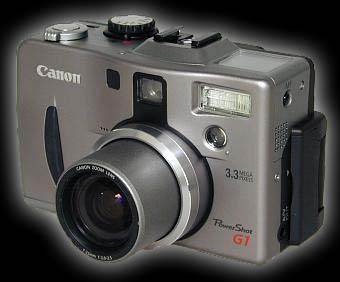
Here is some more practical information and a lot of interesting links:
| Christoph Petermann | Homepage |
|
Astrophotography - Digital Astro Imaging
|
Last Update: 27 October 2001
Part 1 | The Canon Powershot G1 Camera
Part 2 | First Astroimages with G1
Part 3 | Lunar Images
Part 4 | Trying Deepsky
Part 5 | Imaging the Planets
Part 6 | Comets
In June 2001 I purchased at Photo Tip in Kiel a digital camera after a long process of decision. Finally I decided for a CANON Powershot G1. This is a camera with a very "classical" design. Features I like best are the additional lens adaptation, the flash-shoe, the fast lens (f=2.0 .. 2.5), and and ...
I have tried out many situations already with this new camera and I must admit, I am very surprised about the quality of the images. So why not trying out some astrophotography. Stars in the first test shots down here easily reach mag 7.0 and under dark sky the results should dramatically improve. With a carefully made adaptation to my 150mm/f5 Newton telescope I expect magnitudes of better than 13 mag with a single image. Good enough to capture star clusters and brighter galaxies. Using modern techniques it will be possible to add a row of images and gain 2 magnitudes with adding 20 images for a total integration time of 160 seconds.
On the evening of 18 July I found sensitivity better than 9.0 mag, which I could veryfy on 23 July and 25 July. The JPEG compression produces artefacts that can be reduced, if super-fine-quality is used. There are still artefacts, which I eliminated by choosing RAW data format. The G1 was mounted on the EQ5 mount and tracking switched on.
Also possible with this camera should be Aurora imaging. I suppose that the sensitivity is good enough, even though noise does come up while using ISO400 settings with 8 seconds exposure time. I have made some photos of noctilucent clouds on 17 July 2001 which were not very bright. But the images with ISO50 are excellent. The sky background light was similar to a bright aurora.
I will build an adaptation for my telescope and the eyepiece projection adapter for high resolution images of the moon and the planets.
I have tried to take images through an eyepiece now. This resulted in a lot of vignetting, as the Canon lens on the camera has f=2.0 and is quite big. A wide-angle eyepiece is needed ???
Maximum focal length is 21 mm (Minimum = 7 mm). The effective aperture can be calculated from the f ratio: A = 21 mm * 1/2.5 = 8.4 mm. With this aperture about 10 mag can be reached.
The magnitude that can be reached with a telescope then can be calculated with the step-up formula addedmag = 2.5 * log10 ( D / d )2, where D and d are the different diameters of the lenses. My f/5 150 mm Newton has about 75% efficiency, that means it collects light like a 110 mm Refractor. So I calculate 2.5 * log10 ( 110 / 8.4 )2 = 5.58 addedmag. So I will hopefully reach about 15.6 mag. Not a bad value ...

|
If you want to know more about this camera, please look at the pages of
Here is some more practical information and a lot of interesting links: |
The G1 has a thread to mount some lens extensions like wide-angle-lenses or tele-lenses. Canon has a ring adapter which leads to a 58mm of diameter connector for the extension lenses or filters. This adapter however covers the build-in finder and the flashlight. In the internernet I found an adapter of smaller size at LensMate which I ordered. It fits perfectly and has a 49 mm * 0.75 standard filter thread. From here I have to step to T2 for my eyepiece holder. This stepring (or whatever) is priced around US$ 30.-. I have an idea of making it of my own. I will describe it here.
|
Text and All Images are Copyright by Christoph Petermann
DF9CY
|
GO (back) and visit my homepage